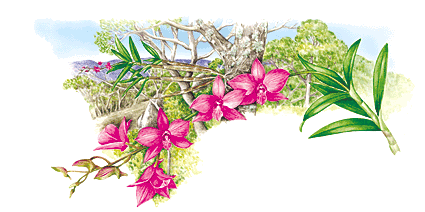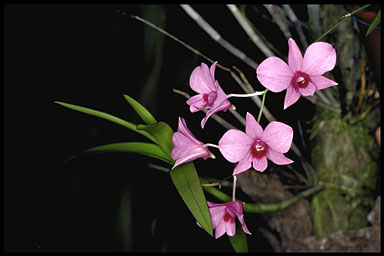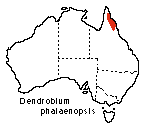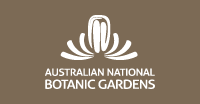 Cooktown
Orchid
Cooktown
Orchid
Dendrobium phalaenopsis
(plant family: Orchidaceae)
Floral Emblem of Queensland
When Queensland prepared for its Centenary in 1959, it sought advice on native species suitable as a floral emblem. The species suggested were Cooktown Orchid (then thought to be Dendrobium bigibbum), Red Silky Oak (Grevillea banksii), Umbrella Tree (Brassaia (now Schefflera) actinophylla), and Wheel of Fire (Stenocarpus sinuatus). A Brisbane newspaper, the Courier-Mail, sought additional suggestions from its readers and finally compiled a list of thirteen species. In a public poll for the most popular choice as floral emblem, 10,917 entries were submitted and according to the organiser 'the Cooktown Orchid, Queensland's own world-famous hybrid [sic] orchid came out thousands ahead in the count of votes'. Grevillea banksii was second, and third was Euphorbia pulcherrima, Poinsettia, a Mexican species already used as the floral emblem of the capital city, Brisbane.
 On
19 November 1959 the Cooktown Orchid, under the botanical name of Dendrobium
bigibbum var phalaenopsis, was proclaimed as the floral emblem of
Queensland (Act). It conformed
with the Government's criteria in being an easily cultivated native species
confined to Queensland, decorative and distinctive in appearance, and coloured
close to the State colour, maroon.
On
19 November 1959 the Cooktown Orchid, under the botanical name of Dendrobium
bigibbum var phalaenopsis, was proclaimed as the floral emblem of
Queensland (Act). It conformed
with the Government's criteria in being an easily cultivated native species
confined to Queensland, decorative and distinctive in appearance, and coloured
close to the State colour, maroon.
The correct botanical name for the Cooktown Orchid has, however, been the subject of continuing speculation and debate.
Plants of Dendrobium bigibbum were first collected by a Dr Thomson on Mount Adolphus, a small island about 18 km north-east of Cape York. These plants were sent to a nursery in London, and in 1852 the species was described and named by the British botanist, John Lindley (1799-1865). It does not occur near Cooktown.
Dendrobium phalaenopsis was described by Robert FitzGerald, Surveyor General of New South Wales in 1880. In his description he included the words "It was obtained near Cooktown, Queensland". In December of the same year he published a beautiful colour plate of Dendrobium phalaenopsis in 'Australian Orchids' with the words "obtained in northern Queensland", which clearly illustrates the plant people now know as the Cooktown Orchid.
The generic name Dendrobium is derived from the Greek 'dendron', meaning 'tree', and 'bios', meaning 'life'; plants of many species of this genus perch on tree trunks and branches. The specific name phalaenopsis from the Greek 'phalaina', meaning 'moth', due to the flower's resemblance to a moth. Dendrobium is a very large genus of more than 1400 species in south and east Asia and in the south-west Pacific. Dendrobium belongs to the orchid family, the largest family of flowering plants. This family is distributed widely throughout the world, with the greatest number in tropical areas.
The common name, Cooktown Orchid, refers to the northern Queensland town, Cooktown, which lies within the distribution of the species on the Endeavour River, named by Captain Cook after his ship was repaired there in 1770.
Plants are up to 80 cm in height, comprising 3-20 flowering canes up to 1.5 cm in diameter. Three to six lance-shaped leaves, 5-12 cm long, are arranged on the upper parts of the pseudobulbs. The stems bearing the flowers are 10 to 40 cm long, carrying up to 20 flowers. Each flower is about 3 to 6 cm wide and usually coloured deep to pale lilac, or rarely white. It usually flowers in the dry season in the wild, but may flower throughout the year in cultivation.
 It
occurs naturally in northern Queensland, from Johnston River to Iron Range.
Although it is found in tropical districts with very high summer rainfall, it
is not a rainforest species but grows in exposed situations, usually attached
to tree trunks such as paperbark melaleucas in savanah woodland or in vine thickets.
Habitat alteration and indiscriminate harvesting by some commercial plant collectors
have made this species rare or extinct in some places within its range, especially
in the southern part.
It
occurs naturally in northern Queensland, from Johnston River to Iron Range.
Although it is found in tropical districts with very high summer rainfall, it
is not a rainforest species but grows in exposed situations, usually attached
to tree trunks such as paperbark melaleucas in savanah woodland or in vine thickets.
Habitat alteration and indiscriminate harvesting by some commercial plant collectors
have made this species rare or extinct in some places within its range, especially
in the southern part.
Cooktown Orchids may be propagated from seed by commercial orchid laboratories, or mature plants may be divided at any time. As far south as Brisbane it is suitable for outdoor cultivation attached by wire or twine to the sunny eastern or northern side of a tree with persistent bark. Until the roots become fully established on the bark surface, they should be protected by a piece of hessian to avoid drying. A slab of cork provides a satisfactory alternative to cultivation on living bark. It may also be grown in pots or baskets, using fern fibre as a growing medium over a deep layer of broken crocks to provide effective drainage. South of Brisbane, glasshouse cultivation is necessary using pots or cork slabs. Generous watering must be provided during summer when growth is active. Winter watering is required only to avoid shrivelling, otherwise the plant is liable to decay and leaf-drop. Light applications of organic or artificial fertiliser during summer improve the number and size of flowers.
It is an ideal cut flower in autumn and winter, lasting up to two weeks in water, especially if pollination has not occurred. Flower-spikes can last up to three months, giving the species considerable commercial potential as an indoor flowering plant suitable for warm well lit rooms. Variations in the size and colour of flowers and the size of pseudobulbs have been noted. Several varieties have been described but these represent the extremes of a continuously varying range of shapes and colours of the flowers.
Cooktown Orchid is considered one of Australia's showiest orchid species and has been successfully cultivated in heated glasshouses in England since the latter part of the nineteenth century. In recent years they have been exported from Australia to New Zealand, USA, Papua New Guinea and Fiji.
The Cooktown Orchid was depicted on the 25 cent stamp [illust] of the State floral emblem set issued on 10 July 1968, designed by R. and P. Warner. It was depicted again in 1998 on a $1.20 stamp [illust] designed by Cathleen Cram with illustrations by artist Clare Kaegi.
Download a line illustration by Marion Westmacott.©
Download copyright-free illustration by Fay Davies, suitable for childrens' colouring.
Badge, Arms, Floral and other Emblems
of Queensland Act 1959 (PDF)
Updated from text by Anne Boden for a booklet published by AGPS for the ANBG in 1985.
![An Australian Government Initiative [logo]](/images/austgovt_brown_90px.gif)







